Microstructure Evolution and Shear Strength of Tin-Indium-xCu/Cu Joints
Abstract
:1. Introduction
2. Materials and Methods
2.1. Alloys and Fabrication of Alloy Joints
2.2. Characterization
3. Results and Discussion
3.1. Wettability
3.2. Microstructure Evolution
3.3. Elastic Modulus of Alloys
3.4. Shear Strength and Fracture Behavior of Solder Joint
4. Conclusions
Author Contributions
Funding
Data Availability Statement
Acknowledgments
Conflicts of Interest
References
- Zardetto, V.; Brown, T.M.; Reale, A.; Di Carlo, A. Substrates for flexible electronics: A practical investigation on the electrical, film flexibility, optical, temperature, and solvent resistance properties. J. Polym. Sci. Part B Polym. Phys. 2011, 49, 638–648. [Google Scholar] [CrossRef]
- Khan, Y.; Thielens, A.; Muin, S.; Ting, J.; Baumbauer, C.; Arias, A.C. A New Frontier of Printed Electronics: Flexible Hybrid Electronics. Adv. Mater. 2019, 32, 1–29. [Google Scholar] [CrossRef]
- Corzo, D.; Tostado-Blázquez, G.; Baran, D. Flexible Electronics: Status, Challenges and Opportunities. Front. Electron. 2020, 1, 1–13. [Google Scholar] [CrossRef]
- Wang, P.; Hu, M.; Wang, H.; Chen, Z.; Feng, Y.; Wang, J.; Ling, W.; Huang, Y. The Evolution of Flexible Electronics: From Nature, Beyond Nature, and To Nature. Adv. Sci. 2020, 7, 1–29. [Google Scholar] [CrossRef] [PubMed]
- Zhang, P.; Xue, S.; Wang, J. New challenges of miniaturization of electronic devices: Electromigration and thermomigration in lead-free solder joints. Mater. Des. 2020, 192, 108726. [Google Scholar] [CrossRef]
- Abtew, M.; Selvaduray, G. Lead-free solders in microelectronics. Mater. Sci. Eng. R Rep. 2000, 27, 95–141. [Google Scholar] [CrossRef]
- Jiang, N.; Zhang, L.; Liu, Z.Q.; Sun, L.; Long, W.M.; He, P.; Xiong, M.Y.; Zhao, M. Reliability issues of lead-free solder joints in electronic devices. Sci. Technol. Adv. Mater. 2019, 20, 876–901. [Google Scholar] [CrossRef] [PubMed] [Green Version]
- Jeong, G.; Yu, D.-Y.; Baek, S.; Bang, J.; Lee, T.-I.; Jung, S.-B.; Kim, J.; Ko, Y.-H. Interfacial Reactions and Mechanical Properties of Sn–58Bi Solder Joints with Ag Nanoparticles Prepared Using Ultra-Fast Laser Bonding. Materials 2021, 14, 335. [Google Scholar] [CrossRef]
- Lee, C.-J.; Min, K.D.; Park, H.J.; Jung, S.-B. Mechanical properties of Sn-58 wt%Bi solder containing Ag-decorated MWCNT with thermal aging tests. J. Alloy. Compd. 2019, 820, 153077. [Google Scholar] [CrossRef]
- Le Han, D.; Shen, Y.-A.; Jin, S.; Nishikawa, H. Microstructure and mechanical properties of the In–48Sn–xAg low-temperature alloy. J. Mater. Sci. 2020, 55, 10824–10832. [Google Scholar] [CrossRef]
- Spinella, L.; Bosco, N. Thermomechanical fatigue resistance of low temperature solder for multiwire interconnects in photovoltaic modules. Sol. Energy Mater. Sol. Cells 2021, 225, 111054. [Google Scholar] [CrossRef]
- Jiang, N.; Zhang, L.; Gao, L.-L.; Song, X.-G.; He, P. Recent advances on SnBi low-temperature solder for electronic interconnections. J. Mater. Sci. Mater. Electron. 2021, 32, 22731–22759. [Google Scholar] [CrossRef]
- Shen, Y.-A.; Zhou, S.; Li, J.; Yang, C.; Huang, S.; Lin, S.; Nishikawa, H. Sn-3.0Ag-0.5Cu/Sn-58Bi composite solder joint assembled using a low-temperature reflow process for PoP technology. Mater. Des. 2019, 183, 108144. [Google Scholar] [CrossRef]
- Shen, Y.-A.; Chen, S.-W.; Chen, H.-Z.; Chang, C.-M.; Ouyang, Y.-H. Extremely thin interlayer of multi-element intermetallic compound between Sn-based solders and FeCoNiMn high-entropy alloy. Appl. Surf. Sci. 2021, 558, 149945. [Google Scholar] [CrossRef]
- Davila-Frias, A.; Yadav, O.P.; Marinov, V. A Review of Methods for the Reliability Testing of Flexible Hybrid Electronics. IEEE Trans. Compon. Packag. Manuf. Technol. 2020, 10, 1902–1912. [Google Scholar] [CrossRef]
- Kim, D.-G.; Jung, S.-B. Interfacial reactions and growth kinetics for intermetallic compound layer between In–48Sn solder and bare Cu substrate. J. Alloy. Compd. 2005, 386, 151–156. [Google Scholar] [CrossRef]
- Goldstein, J.L.F.; Morris, J.W. The Effect of Substrate on the Microstructure and Mechanical Behavior of Eutectic Indium-Tin. MRS Proc. 1993, 323, 159. [Google Scholar] [CrossRef]
- Chuang, T.H.; Yu, C.L.; Chang, S.Y.; Wang, S.S. Phase identification and growth kinetics of the intermetallic compounds formed during In-49Sn/Cu soldering reactions. J. Electron. Mater. 2002, 31, 640–645. [Google Scholar] [CrossRef]
- Koo, J.-M.; Jung, S.-B. Reliability of in-48Sn solder/Au/Ni/Cu BGA packages during reflow process. J. Electron. Mater. 2005, 34, 1565–1572. [Google Scholar] [CrossRef]
- Le Han, D.; Shen, Y.-A.; He, S.; Nishikawa, H. Effect of Cu addition on the microstructure and mechanical properties of In–Sn-based low-temperature alloy. Mater. Sci. Eng. A 2021, 804, 140785. [Google Scholar] [CrossRef]
- Choi, K.; Lee, H.; Bae, H.; Eom, Y.; Lee, J.H. Interconnection Technology Based on InSn Solder for Flexible Display Applications. ETRI J. 2015, 37, 387–394. [Google Scholar] [CrossRef]
- Evans, J.W. A Guide to Lead-free Solders—Physical Metallurgy and Reliability; Engelmaier, W., Ed.; Springer: London, UK, 2007; ISBN 9781846283093. [Google Scholar]
- Long, X.; Tang, W.; Xu, M.; Keer, L.M.; Yao, Y. Electric current-assisted creep behaviour of Sn–3.0Ag–0.5Cu solder. J. Mater. Sci. 2018, 53, 6219–6229. [Google Scholar] [CrossRef]
- Wang, W.; Chen, Z.; Wang, S.; Long, X. Mechanics-based acceleration for estimating thermal fatigue life of electronic packaging structure. Microelectron. Reliab. 2020, 107, 113616. [Google Scholar] [CrossRef]
- Long, X.; Liu, Y.; Jia, F.; Wu, Y.; Fu, Y.; Zhou, C. Thermal fatigue life of Sn–3.0Ag–0.5Cu solder joint under temperature cycling coupled with electric current. J. Mater. Sci. Mater. Electron. 2019, 30, 7654–7664. [Google Scholar] [CrossRef]
- Seyyedi, J. Thermal Fatigue Behaviour of Low Melting Point Solder Joints. Solder. Surf. Mt. Technol. 1993, 5, 26–32. [Google Scholar] [CrossRef]
- Wang, J.; Mao, D.; Shi, L.; Zhang, W.; Zhang, X. Effect of Zinc Addition on the Microstructure, Thermal and Mechanical Properties of Indium-Tin-xZinc Alloys. J. Electron. Mater. 2019, 48, 817–826. [Google Scholar] [CrossRef]
- Kim, S.H.; Yeon, S.-M.; Kim, J.H.; Park, S.J.; Lee, J.E.; Park, S.-H.; Choi, J.-P.; Aranas, C.J.; Son, Y. Fine Microstructured In–Sn–Bi Solder for Adhesion on a Flexible PET Substrate: Its Effect on Superplasticity and Toughness. ACS Appl. Mater. Interfaces 2019, 11, 17090–17099. [Google Scholar] [CrossRef] [PubMed]
- Das, S.; Sharif, A.; Chan, Y.; Wong, N.; Yung, W.K.C. Influence of small amount of Al and Cu on the microstructure, microhardness and tensile properties of Sn–9Zn binary eutectic solder alloy. J. Alloy. Compd. 2009, 481, 167–172. [Google Scholar] [CrossRef]
- Qiu, J.; Peng, Y.; Gao, P.; Li, C. Effect of Cu Content on Performance of Sn-Zn-Cu Lead-Free Solder Alloys Designed by Cluster-Plus-Glue-Atom Model. Materials 2021, 14, 2335. [Google Scholar] [CrossRef]
- Shen, J.; Pu, Y.; Yin, H.; Luo, D.; Chen, J. Effects of minor Cu and Zn additions on the thermal, microstructure and tensile properties of Sn-Bi-based solder alloys. J. Alloys Compd. 2014, 614, 63–70. [Google Scholar] [CrossRef]
- Said, R.M.; Salleh, M.A.A.M.; Amran, N.A.A.; Ramli, M.I.I. Microstructure Evolution of Sn-Cu Based Solder Paste with Different Cu Concentration Subjected to Multiple Reflows. Solid State Phenom. 2018, 280, 206–211. [Google Scholar] [CrossRef]
- Mehreen, S.U.; Nogita, K.; McDonald, S.; StJohn, D. Effect of Zn addition on Cu3Sn formation in Sn-10Cu alloys. IOP Conf. Series: Mater. Sci. Eng. 2019, 701, 012009. [Google Scholar] [CrossRef]
- Cho, J.; Mallampati, S.; Schoeller, H.; Yin, L.; Shaddock, D. Developments of Bi-Sb-Cu alloys as a high-temperature Pb-free solder. In Proceedings of the 2015 IEEE 65th Electronic Components and Technology Conference (ECTC), San Diego, CA, USA, 26–29 May 2015; 2015; pp. 1251–1256. [Google Scholar] [CrossRef]
- Tumminello, S.; Del Negro, N.; Carrascal, C.; Fries, S.G.; Alonso, P.R.; Sommadossi, S. Multiphase Characterization of Cu-In-Sn Alloys with 17 at.% Cu and Comparison with Calculated Phase Equilibria. J. Phase Equilibria Diffus. 2017, 38, 276–287. [Google Scholar] [CrossRef]
- Yang, L.; Yang, Y.; Zhang, Y.; Xu, F.; Qiao, J.; Lu, W.; Yu, B. Microstructure evolution and mechanical properties of the In–Sn–20Cu composite particles TLP bonding solder joints. Appl. Phys. A 2020, 126, 1–8. [Google Scholar] [CrossRef]
- Susan, D.F.; Rejent, J.A.; Grant, R.P.; Vianco, P.T. The Solidification Behavior and Microstructure of In-Sn-Cu Solder Alloys with Low Cu. In Proceedings of the 4th International Brazing and Soldering Conference, Orlando, FL, USA, 26–29 April 2009; pp. 1–6. [Google Scholar]
- Uemura, T.; Sakai, T.; Sakuyama, S. Improvement of mechanical properties of In-48mass%Sn solder by Ag and Cu addition. In Proceedings of the 2016 IEEE 18th Electronics Packaging Technology Conference (EPTC), Singapore, 30 November–3 December 2016; 2016; pp. 181–184. [Google Scholar] [CrossRef]
- Bai, J.G.; Zhang, Z.Z.; Calata, J.N.; Lu, G.Q. Low-temperature sintered nanoscale silver as a novel semiconductor device-metallized substrate interconnect material. IEEE Trans. Components Packag. Technol. 2006, 29, 589–593. [Google Scholar] [CrossRef]
- Shohji, I.; Fujiwara, S.; Kiyono, S.; Kobayashi, K.F. Intermetallic compound layer formation between Au and In-48Sn solder. Scr. Mater. 1999, 40, 815–820. [Google Scholar] [CrossRef]
- Mannan, S.H.; Clode, M.P.; Dagher, M. Study of intermetallic crystal growth between Nb and molten 52In-48Sn solder. J. Electron. Mater. 2005, 34, 125–131. [Google Scholar] [CrossRef]
- Koo, J.M.; Yoon, J.W.; Jung, S.B. Interfacial reactions between In-48Sn solder and electroless nickel/immersion gold substrate during reflow process. Surf. Interface Anal. 2006, 38, 426–428. [Google Scholar] [CrossRef]
- Freer, J.L.; Morris, J.W. Microstructure and creep of eutectic indium/tin on copper and nickel substrates. J. Electron. Mater. 1992, 21, 647–652. [Google Scholar] [CrossRef]
- Sommadossi, S.; Guillermet, A.F. Interface reaction systematics in the Cu/In-48Sn/Cu system bonded by diffusion soldering. Intermetallics 2007, 15, 912–917. [Google Scholar] [CrossRef]
- Sobczak, N.; Kudyba, A.; Nowak, R.; Radziwill, W.; Pietrzak, K. Factors affecting wettability and bond strength of solder joint couples. Pure Appl. Chem. 2007, 79, 1755–1769. [Google Scholar] [CrossRef] [Green Version]
- Kumar, G.; Prabhu, K.N. Review of non-reactive and reactive wetting of liquids on surfaces. Adv. Colloid Interface Sci. 2007, 133, 61–89. [Google Scholar] [CrossRef]
- Dogan, A.; Arslan, H. Thermophysical properties of Cu–In–Sn liquid Pb-free alloys viscosity and surface tension. Philos. Mag. 2017, 1–18. [Google Scholar] [CrossRef]
- Yakymovych, A.; Vus, V.; Mudry, S. Viscosity of liquid Cu-In-Sn alloys. J. Mol. Liq. 2016, 219, 845–850. [Google Scholar] [CrossRef]
- Noor, E.E.M.; Sharif, N.M.; Yew, C.K.; Ariga, T.; Ismail, A.B.; Hussain, Z. Wettability and strength of In-Bi-Sn lead-free solder alloy on copper substrate. J. Alloys Compd. 2010, 507, 290–296. [Google Scholar] [CrossRef]
- Zang, L.; Yuan, Z.; Zhao, H.; Zhang, X. Wettability of molten Sn–Bi–Cu solder on Cu substrate. Mater. Lett. 2009, 63, 2067–2069. [Google Scholar] [CrossRef]
- Tan, C.Y.; Salleh, M.A.A.M.; Saud, N. The Study of Interfacial Reaction between SnAgCu (SAC) Lead-free Solder Alloys and Copper Substrate: A Short Review. IOP Conf. Series: Mater. Sci. Eng. 2020, 864, 012182. [Google Scholar] [CrossRef]
- Liu, X.J.; Liu, H.S.; Ohnuma, I.; Kainuma, R.; Ishida, K.; Itabashi, S.; Kameda, K.; Yamaguchi, K. Experimental determination and thermodynamic calculation of the phase equilibria in the Cu-In-Sn system. J. Electron. Mater. 2001, 30, 1093–1103. [Google Scholar] [CrossRef]
- Riani, P.; Cacciamani, G.; Parodi, N.; Borzone, G.; Marazza, R.; Nanni, F.; Gusmano, G. Phase equilibria in the In–Sn-rich part of the Cu–In–Sn ternary system. J. Alloys Compd. 2009, 487, 90–97. [Google Scholar] [CrossRef]
- Chen, J.; Zhang, Y.; Yu, Z.; Zhang, P.; Zhao, W.; Yang, J.; Wu, D. Interface growth and void formation in Sn/Cu and Sn0.7Cu/Cu systems. Appl. Sci. 2018, 8, 2703. [Google Scholar] [CrossRef] [Green Version]
- Shang, P.J.; Liu, Z.Q.; Li, D.X.; Shang, J.K. Phase identification of intermetallic compounds formed during In-48Sn/Cu soldering reactions. In Proceedings of the 2009 International Conference on Electronic Packaging Technology & High Density Packaging, Beijing, China, 10–13 August 2009; 2009; pp. 597–600. [Google Scholar] [CrossRef]
- Lin, S.K.; Chung, T.Y.; Chen, S.W.; Chang, C.H. 250 °C isothermal section of ternary Sn-In-Cu phase equilibria. J. Mater. Res. 2009, 24, 2628–2637. [Google Scholar] [CrossRef]
- Tian, F.; Liu, Z.Q.; Shang, P.J.; Guo, J. Phase identification on the intermetallic compound formed between eutectic SnIn solder and single crystalline Cu substrate. J. Alloys Compd. 2014, 591, 351–355. [Google Scholar] [CrossRef]
- Ma, H.C.; Suhling, J. A review of mechanical properties of lead-free solders for electronic packaging. J. Mater. Sci. 2009, 224, 1141–1158. [Google Scholar] [CrossRef]
- Kim, J.-W.; Jung, S.-B. Characterization of the shear test method with low melting point In–48Sn solder joints. Mater. Sci. Eng. A 2005, 397, 145–152. [Google Scholar] [CrossRef]
- Tanaka, H.; Qun, L.F.; Munekata, O.; Taguchi, T.; Narita, T. Elastic Properties of Sn-Based Pb-Free Solder Alloys Determined by Ultrasonic Pulse Echo Method. Mater. Trans. 2005, 46, 1271–1273. [Google Scholar] [CrossRef] [Green Version]
- Bušek, D.; Dušek, K.; Růžička, D.; Plaček, M.; MacH, P.; Urbánek, J.; Starý, J. Flux effect on void quantity and size in soldered joints. Microelectron. Reliab. 2016, 60, 135–140. [Google Scholar] [CrossRef]
- Long, X.; Wang, Y.; Keer, L.M.; Yao, Y. Mechanical effects of isolated defects within a lead-free solder bump subjected to coupled thermal-electrical loading. J. Micromech. Mol. Phys. 2016, 1, 1–17. [Google Scholar] [CrossRef]
- Mahmudi, R.; Sadeghi, M. Correlation between shear punch and tensile strength for low-carbon steel and stainless steel sheets. J. Mater. Eng. Perform. 2013, 22, 433–438. [Google Scholar] [CrossRef]
- Hankin, G.L.; Toloczko, M.B.; Hamilton, M.L.; Faulkner, R.G. Validation of the shear punch-tensile correlation technique using irradiated materials. J. Nucl. Mater. 1998, 258–263, 1651–1656. [Google Scholar] [CrossRef]
- Shin, C.K.; Huh, J.Y. Effect of Cu-containing solders on the critical IMC thickness for the shear strength of BGA solder joints. Proc. Electron. Packag. Technol. Conf. EPTC 2000, 406–411. [Google Scholar] [CrossRef]
- Xinmeng, Z.; Yuefeng, L.; Jun, Z.; Mingming, S.; Bobo, Y.; Yang, L.; Chunfeng, G.; Rongrong, H. Effect of Soldering Temperature on the Reliability of Sn-Ag-Cu Lead-Free Solder Joints. J. Electron. Mater. 2021, 50, 869–880. [Google Scholar] [CrossRef]
- Sun, L.; Chen, M.-H.; Zhang, L.; He, P.; Xie, L.-S. Recent progress in SLID bonding in novel 3D-IC technologies. J. Alloy. Compd. 2019, 818, 152825. [Google Scholar] [CrossRef]

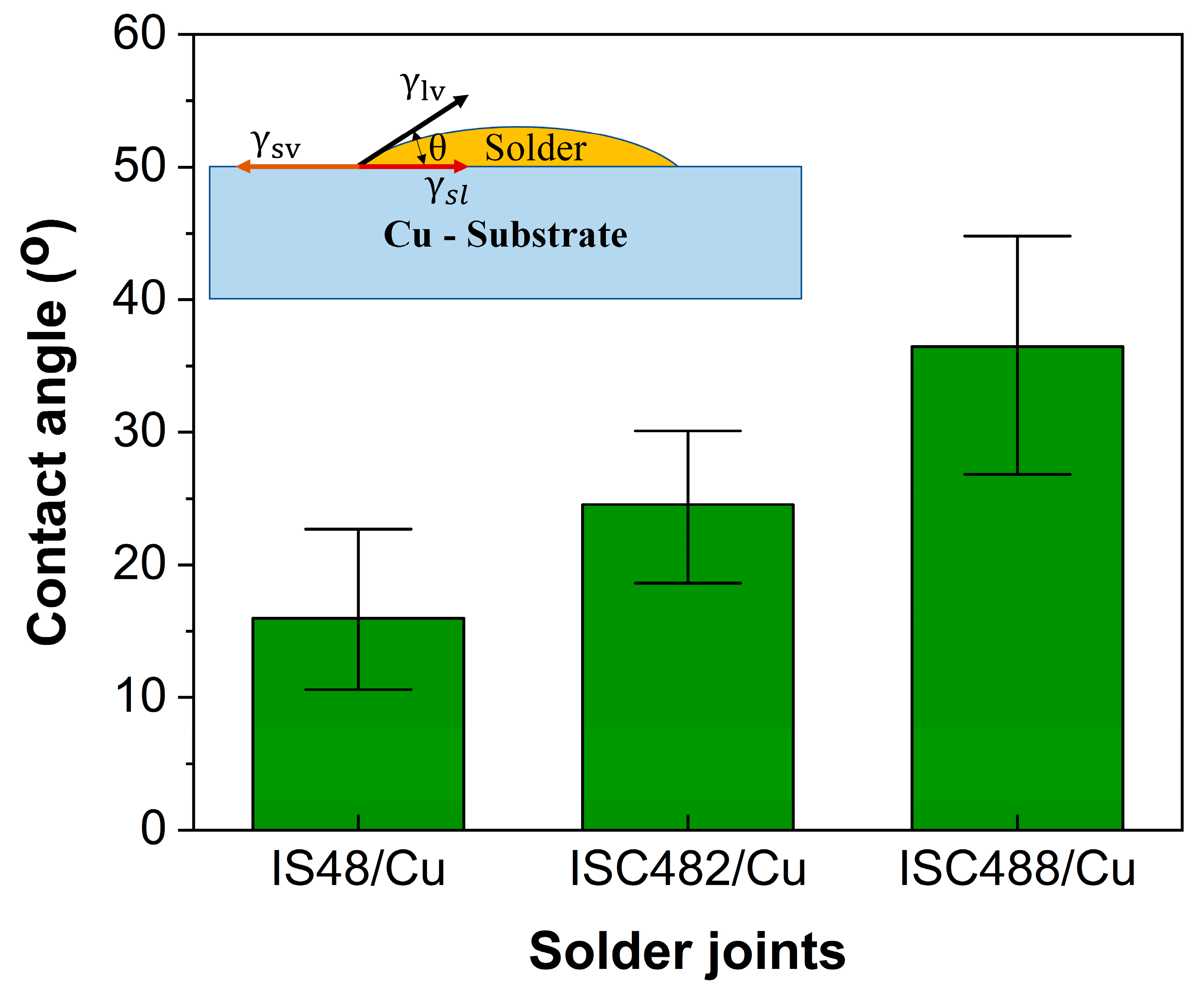
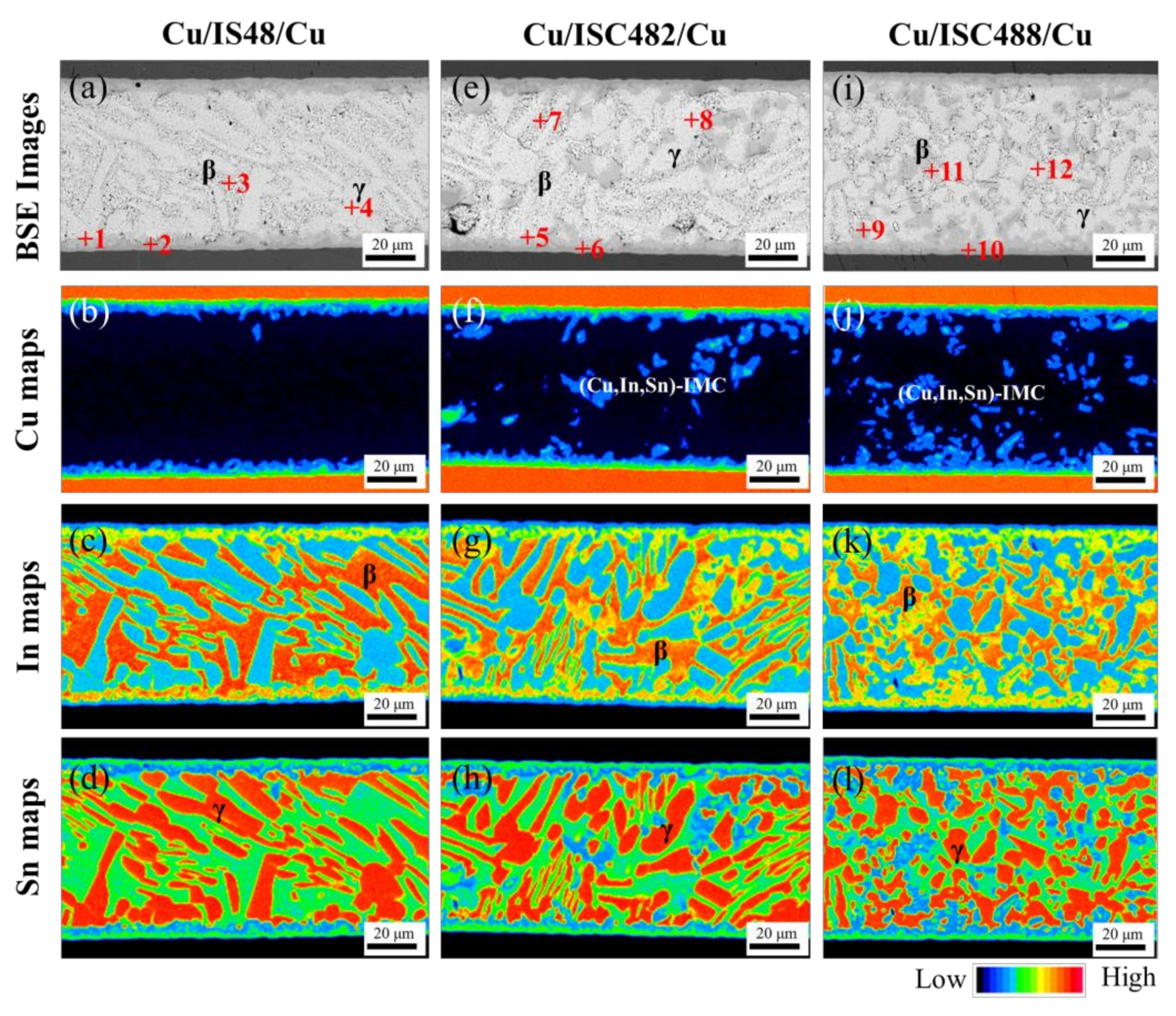
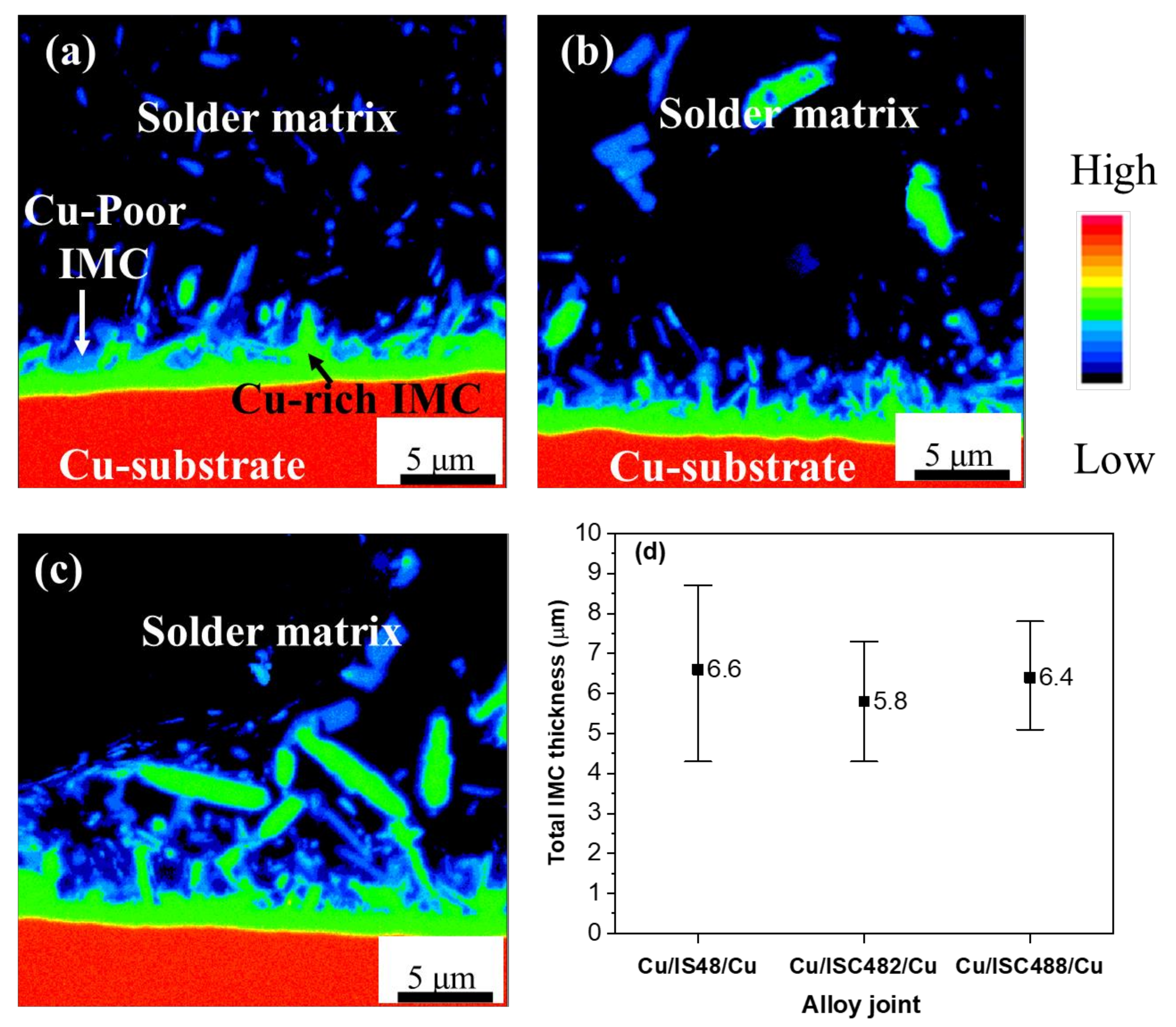
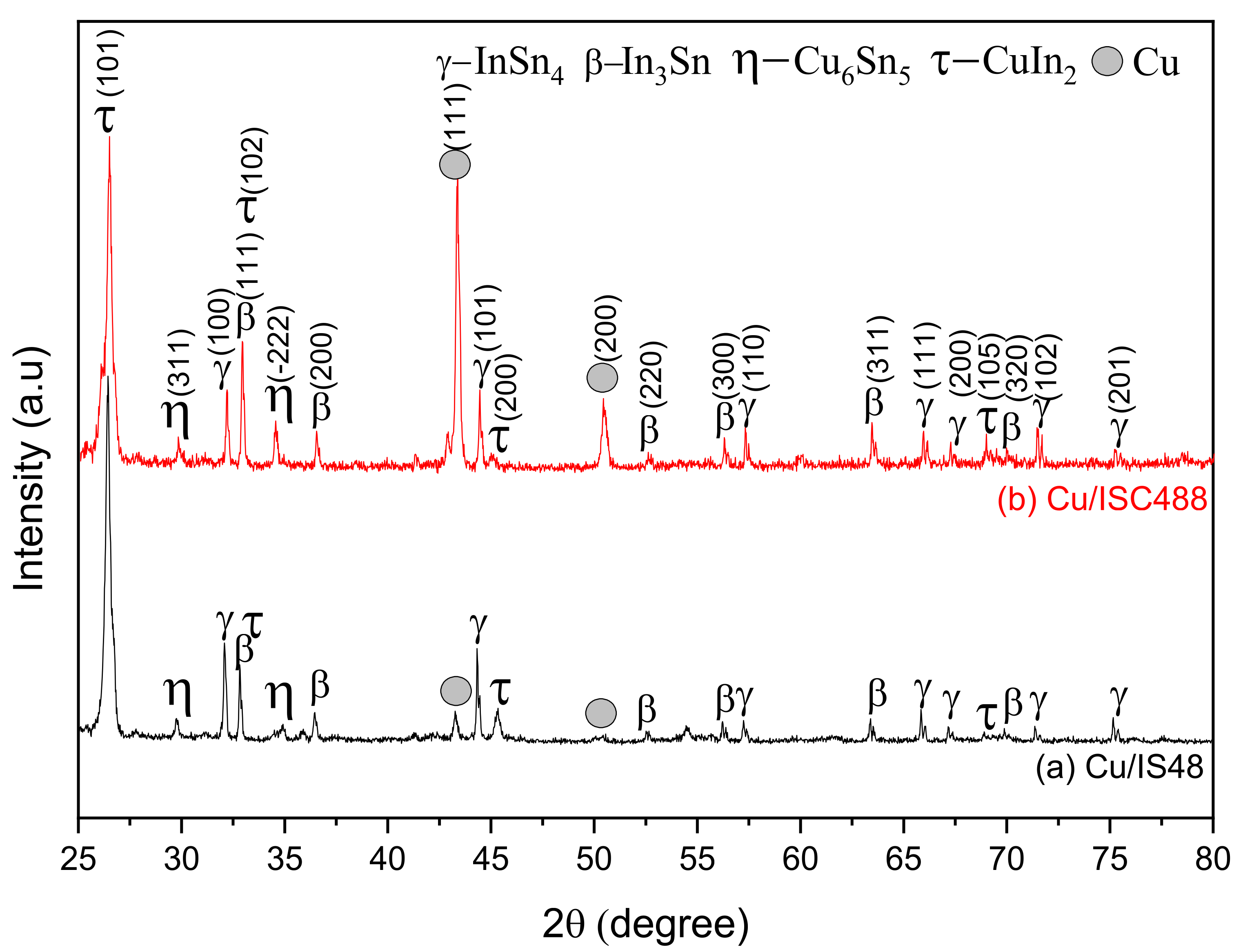

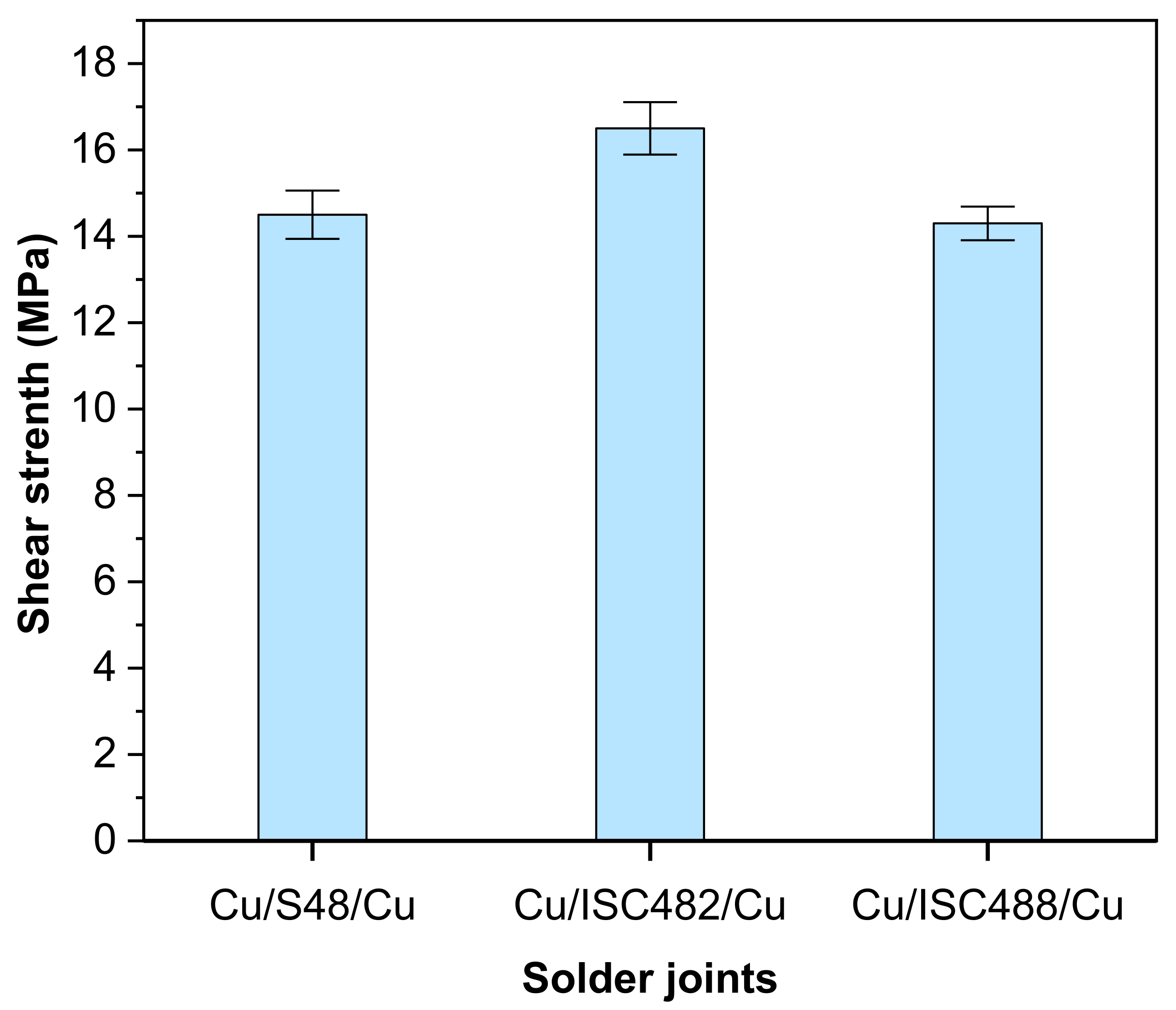

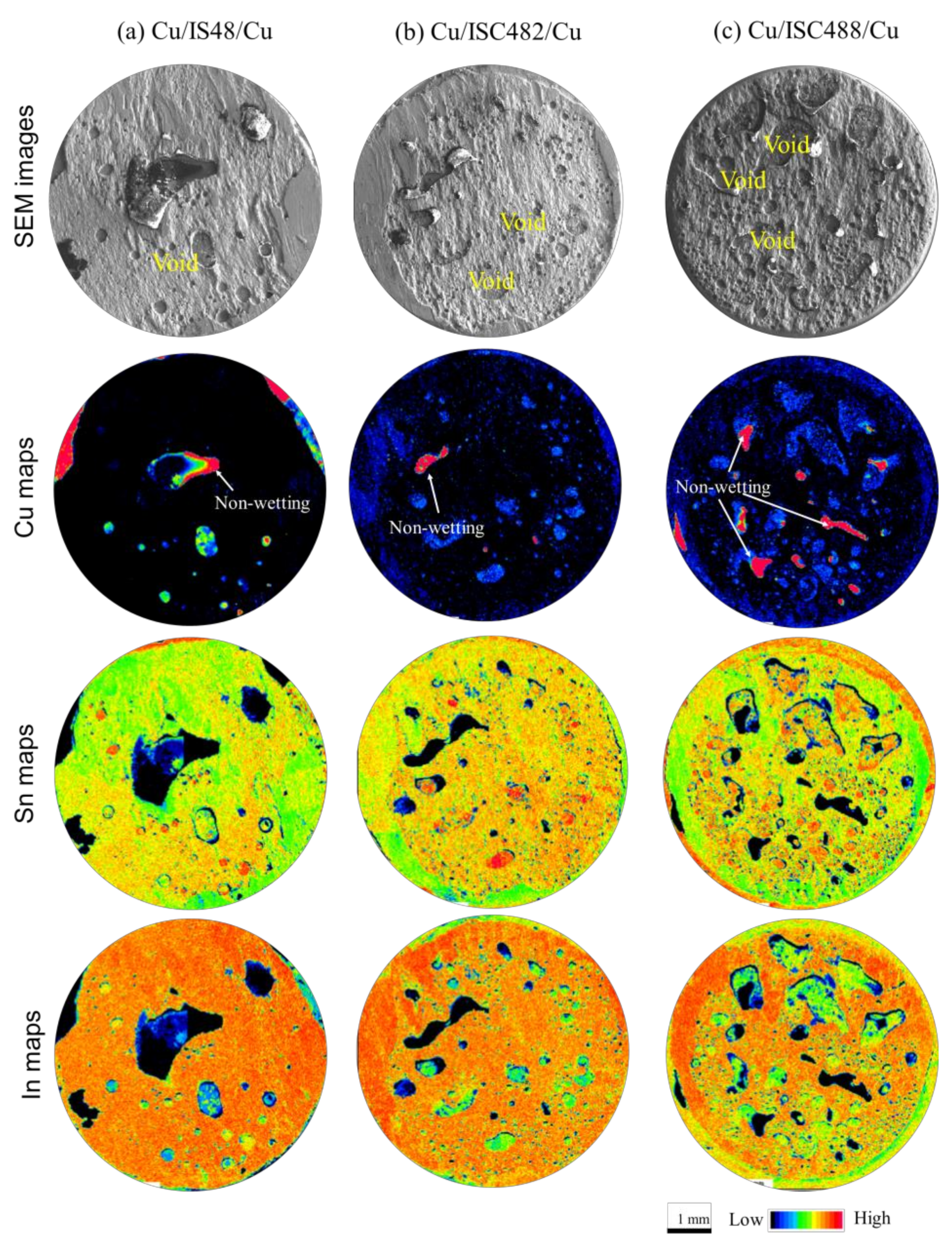
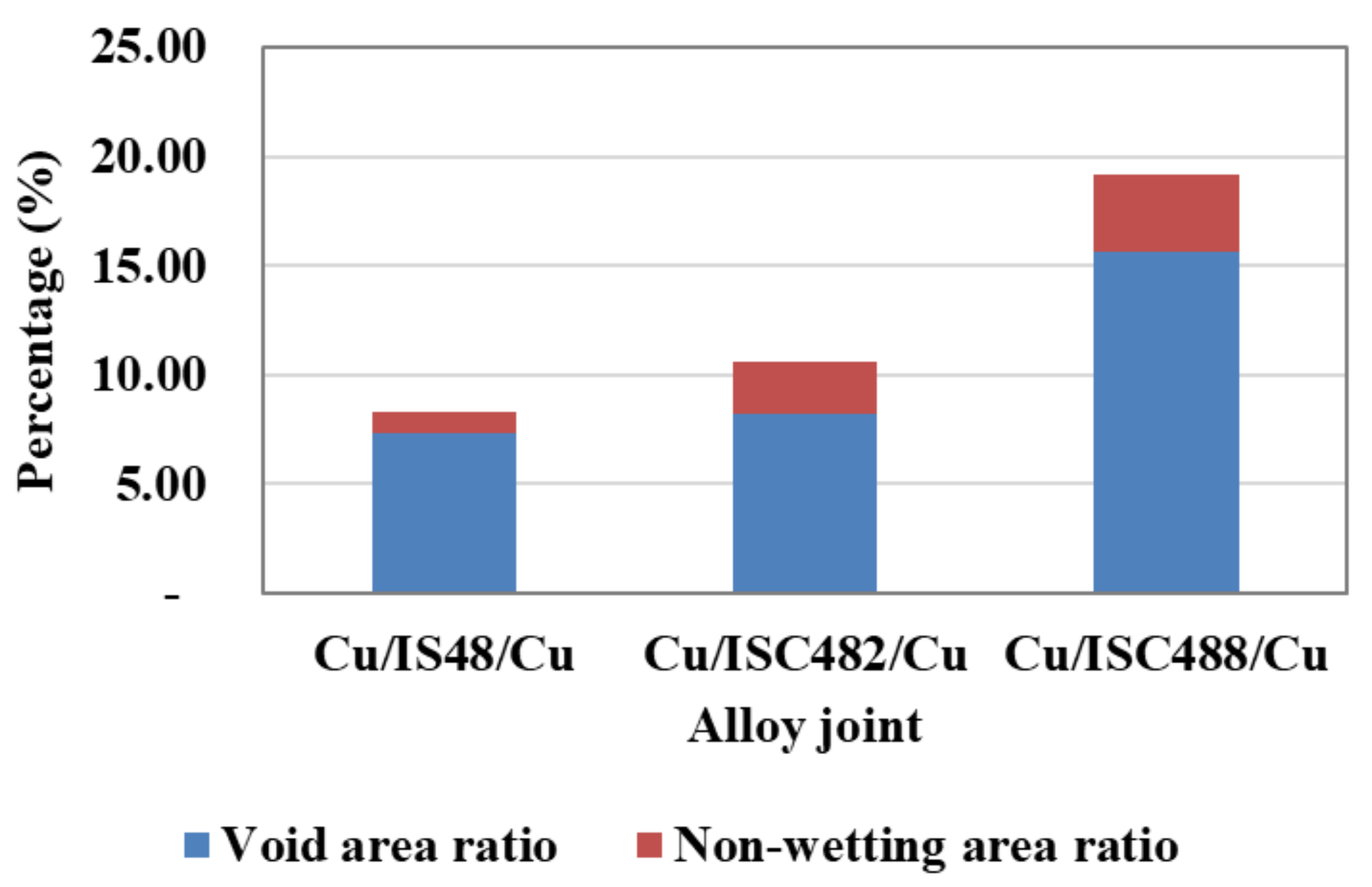

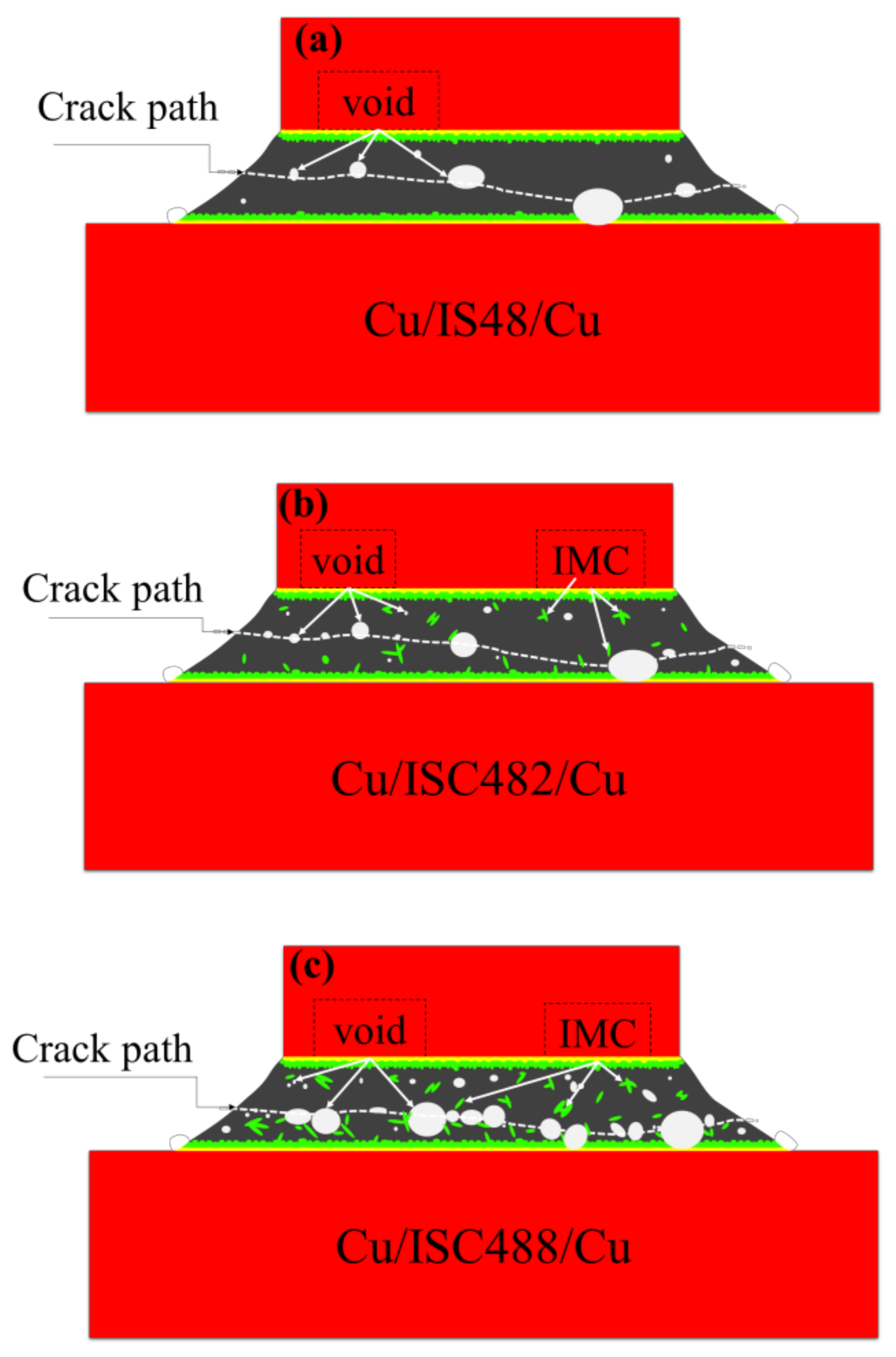
| Element | ISC482 (wt.%) | ISC488 (wt.%) | IS48 (wt.%) |
|---|---|---|---|
| Sn | 47.720 | 45.000 | 48.200 |
| In | Balance | Balance | Balance |
| Cu | 1.530 | 7.370 | 0.003 |
| Ni | 0.001 | 0.001 | 0.001 |
| Bi | – | – | 0.02 |
| Pb | 0.001 | 0.001 | 0.001 |
| Alloy Joint | Point | In (at.%) | Sn (at.%) | Cu (at.%) | Estimated IMC |
|---|---|---|---|---|---|
| Cu/IS48/Cu | 1 | 52.72 | 15.92 | 31.36 | τ-Cu(In,Sn)2 |
| 2 | 20.60 | 22.89 | 56.51 | η-Cu6(In,Sn)5 | |
| 3 | 75.75 | 24.20 | 0.05 | β-In3Sn | |
| 4 | 24.53 | 75.40 | 0.07 | γ-InSn4 | |
| Cu/ISC482/Cu | 5 | 53.83 | 14.01 | 32.16 | τ-Cu(In,Sn)2 |
| 6 | 20.39 | 22.72 | 56.89 | η-Cu6(In,Sn)5 | |
| 7 | 75.61 | 23.63 | 0.76 | β-In3Sn | |
| 8 | 24.03 | 75.14 | 0.83 | γ-InSn4 | |
| Cu/ISC488/Cu | 9 | 54.93 | 14.12 | 30.95 | τ-Cu(In,Sn)2 |
| 10 | 23.74 | 17.77 | 58.49 | η-Cu6(In,Sn)5 | |
| 11 | 73.98 | 25.09 | 0.93 | β-In3Sn | |
| 12 | 24.94 | 74.19 | 0.87 | γ-InSn4 |
Publisher’s Note: MDPI stays neutral with regard to jurisdictional claims in published maps and institutional affiliations. |
© 2021 by the authors. Licensee MDPI, Basel, Switzerland. This article is an open access article distributed under the terms and conditions of the Creative Commons Attribution (CC BY) license (https://creativecommons.org/licenses/by/4.0/).
Share and Cite
Han, D.L.; Shen, Y.-A.; Huo, F.; Nishikawa, H. Microstructure Evolution and Shear Strength of Tin-Indium-xCu/Cu Joints. Metals 2022, 12, 33. https://doi.org/10.3390/met12010033
Han DL, Shen Y-A, Huo F, Nishikawa H. Microstructure Evolution and Shear Strength of Tin-Indium-xCu/Cu Joints. Metals. 2022; 12(1):33. https://doi.org/10.3390/met12010033
Chicago/Turabian StyleHan, Duy Le, Yu-An Shen, Fupeng Huo, and Hiroshi Nishikawa. 2022. "Microstructure Evolution and Shear Strength of Tin-Indium-xCu/Cu Joints" Metals 12, no. 1: 33. https://doi.org/10.3390/met12010033
APA StyleHan, D. L., Shen, Y.-A., Huo, F., & Nishikawa, H. (2022). Microstructure Evolution and Shear Strength of Tin-Indium-xCu/Cu Joints. Metals, 12(1), 33. https://doi.org/10.3390/met12010033







